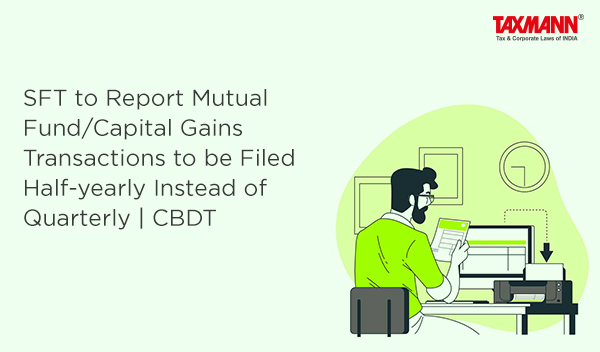SFT to Report Mutual Fund/Capital Gains Transactions to be Filed Half-yearly Instead of Quarterly | CBDT
- Blog|News|Income Tax|
- 2 Min Read
- By Taxmann
- |
- Last Updated on 22 November, 2023

Corrigendum to notification no. 3 & 4 of 2021, dated 15-11-2023
The Board vide Notification Nos. 3 & 4 of 2021, dated 30-04-2021 specified the guidelines for preparation and submission of statement of financial transaction (SFT) in relation to capital gains/mutual fund transactions.
The Board has issued corrigendum to said notifications tweaking norms related to the filing of SFTs which has been discussed below:
(a) Starting April 1, 2023, SFT will switch from quarterly to half-yearly submission. This means that data for the first half of the fiscal year ending on September 30th and the second half ending on March 31st will now be provided by October 31st and April 30th respectively.
(b) The holding period for UTI units is set at 12 months if over 35% of the proceeds are in domestic equity shares. For Business Trust and Other Units, the holding period is 36 months under the same conditions.
(c) Starting from 01-04-2023, if UTI unit, Business Trust and Other Units invest 35% of less of its total proceeds in the equity shares of domestic companies, (Specified Mutual Fund), it will always be classified as short-term capital asset.
(d) The corrigendum includes Market Linked Debentures in the classification of short-term capital assets starting from April 1, 2024.
(e) Regarding SFT in Depository Transactions, the Corrigendum specifies that for each debit transaction, the matching credit should be identified using the First in First Out (FIFO) method. The estimated acquisition cost for the credit should be calculated using the weighted average price of the asset. This involves considering the actual transaction value if the purchase was made after February 1, 2018, or the end-of-day price if the purchase was made before that date, as available with the depository.
(f) Corrigendum further clarifies that the estimated acquisition cost is considered NIL for off-market purchases, corporate actions, or any transactions outside the Exchange. Additionally, IPO credits will be regarded as market credits, with the acquisition cost calculated using the formula ‘Number of allotted shares x Per unit price at the time of allocation’.
Click Here To Read The Full Updates
Disclaimer: The content/information published on the website is only for general information of the user and shall not be construed as legal advice. While the Taxmann has exercised reasonable efforts to ensure the veracity of information/content published, Taxmann shall be under no liability in any manner whatsoever for incorrect information, if any.

Taxmann Publications has a dedicated in-house Research & Editorial Team. This team consists of a team of Chartered Accountants, Company Secretaries, and Lawyers. This team works under the guidance and supervision of editor-in-chief Mr Rakesh Bhargava.
The Research and Editorial Team is responsible for developing reliable and accurate content for the readers. The team follows the six-sigma approach to achieve the benchmark of zero error in its publications and research platforms. The team ensures that the following publication guidelines are thoroughly followed while developing the content:
- The statutory material is obtained only from the authorized and reliable sources
- All the latest developments in the judicial and legislative fields are covered
- Prepare the analytical write-ups on current, controversial, and important issues to help the readers to understand the concept and its implications
- Every content published by Taxmann is complete, accurate and lucid
- All evidence-based statements are supported with proper reference to Section, Circular No., Notification No. or citations
- The golden rules of grammar, style and consistency are thoroughly followed
- Font and size that’s easy to read and remain consistent across all imprint and digital publications are applied




